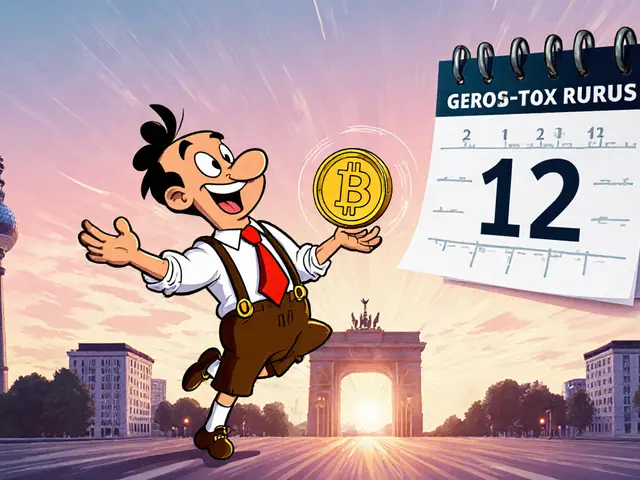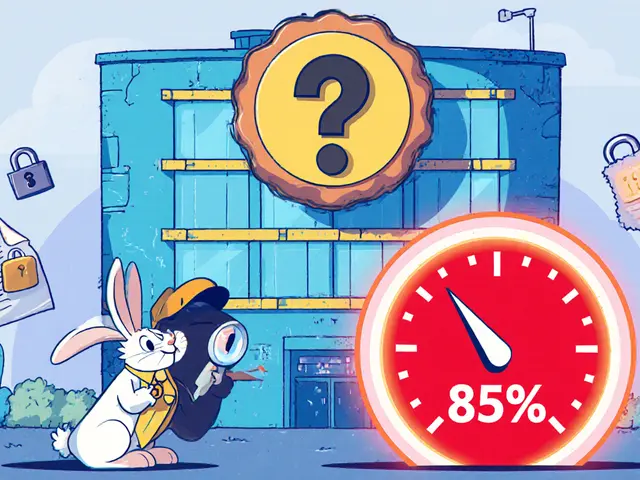
India Crypto Tax Calculator
Tax Calculation Parameters
Enter your trading details below to see how India's crypto tax rules apply to your situation.
Your Tax Breakdown
Important Notes
- This calculator applies the current Indian crypto tax rules: 30% flat tax on gains, 1% TDS, and 18% GST on platform fees.
- Losses cannot be offset against other income in India.
- Results are estimates only and do not constitute tax advice.
India sits at the top of the global crypto adoption leaderboard, even though its tax regime is among the toughest on the planet. How does a market with a 30% flat tax, mandatory 1% TDS, and an 18% GST on platform fees keep attracting fresh users and massive trading volumes? This article breaks down the paradox, explains the tax rules, shows the real‑world impact on traders, and outlines what’s coming next.
TL;DR
- India ranks #1 in crypto adoption despite a 30% flat tax on gains.
- Tax rules include a 1% TDS on each trade over ₹50,000 and 18% GST on exchange services.
- Key drivers: young population, mobile‑first internet, robust exchange infrastructure, and strong community momentum.
- Regulators are reviewing the framework; possible easing could happen in 2026.
- For traders, a compliance checklist can keep tax headaches manageable.
1. The Adoption Engine: Why India Keeps Growing
India is a country of over 1.4billion people, with more than 750million internet users, the majority accessing the web via smartphones. This massive, mobile‑first audience has created a perfect breeding ground for digital assets.
Three concrete forces push adoption higher than anywhere else:
- Demographic momentum: Over 65% of the population is under 35, a group that embraces new tech and looks for alternative wealth‑building tools.
- Exchange ecosystem: Home‑grown platforms like WazirX, CoinDCX, and ZebPay have built simple UI/UX, KYC onboarding in minutes, and deep integration with UPI payments, making crypto purchases as easy as sending money to a friend.
- Community narrative: Social media channels, Telegram groups, and local meet‑ups constantly share success stories, turning crypto into a cultural conversation rather than a niche hobby.
These drivers offset the tax deterrents, especially because many users view crypto as a hedge against inflation and a path to financial independence.
2. The Tax Landscape: Numbers, Rules, and What They Mean
Virtual Digital Asset (VDA) is the term India uses to classify cryptocurrencies, NFTs, and similar tokens under Section 2(47A) of the Income Tax Act. The classification allows trading but stops short of declaring them legal tender.
The current tax regime, in place since FY2022, contains three main components:
- Flat 30% tax on all gains: Whether you made ₹10crore from Bitcoin or a modest profit from a meme token, the taxable portion is the same. No capital‑gains exemption thresholds apply.
- 1% Tax Deducted at Source (TDS): Every transaction above ₹50,000 triggers an automatic 1% deduction by the exchange. The amount is credited to the trader’s tax account, regardless of profit or loss.
- 18% Goods and Services Tax (GST) on platform services: Starting July2025, exchanges are treated as "Online Service Providers" under the CGST Act, meaning fees for spot trading, margin, staking, and even custodial storage attract GST.
Because losses cannot be set off against gains-neither within crypto nor against other income-the tax bite can exceed actual profits during volatile periods. Moreover, the mandatory ScheduleVDA filing in every Income Tax Return forces users to disclose every wallet address and transaction, creating a full audit trail.
3. Real‑World Impact on Traders and Platforms
To grasp the pain points, look at a typical high‑frequency trader who makes 100 trades a day, each worth ₹60,000. The 1% TDS alone drains ₹60,000 daily (₹2.1million a month), before any profit calculation. Add the 30% tax on net gains and 18% GST on fees, and the effective cost of trading can eclipse 50% of gross returns.
Despite this, traders stay active for three reasons:
- Liquidity pull: Indian exchanges control a large share of the local order book, offering tighter spreads than overseas venues.
- Regulatory certainty: While harsh, the rules are clear; users know exactly what to expect at tax time.
- Community tools: Open‑source tax calculators, Excel templates, and third‑party compliance services have sprung up to automate ScheduleVDA filing.
Platforms, on the other hand, face a heavy compliance load. They must integrate TDS deduction engines, register for GST regardless of turnover, and maintain AML/KYC records for every user. Some mid‑size exchanges have shut down or moved operations offshore to avoid the GST burden, which has led to a modest migration of trading volume to foreign platforms.

4. How India Stacks Up Against Other Crypto Tax Regimes
| Country | Tax Rate on Gains | Loss Offset Allowed? | TDS / Withholding | GST / VAT on Platform Fees |
|---|---|---|---|---|
| India | 30% flat | No | 1% on trades > ₹50k | 18% GST |
| Germany | 0% after 1year holding | Yes | None | 19% VAT on services |
| Singapore | 0% (no capital gains) | Not applicable | None | 7% GST on fees |
| USA (Federal) | 15-37% (depending on income bracket) | Yes (limited) | None | Varies by state |
| Australia | 15% (CGT discount if held >1yr) | Yes | None | 10% GST on services |
Even though India’s tax rate is the highest among the listed economies, the country still outpaces them in user count because the other variables-population size, smartphone penetration, and cultural appetite for risk-are far more decisive.
5. Regulatory Pulse: The CBDT Consultation and What May Change
In August2025, the Central Board of Direct Taxes (CBDT) launched a comprehensive questionnaire targeting exchanges, crypto traders, and tax professionals. The key questions are:
- Should a dedicated crypto law replace the ad‑hoc VDA classification?
- Is the 1% TDS on every trade too punitive for market liquidity?
- Can loss‑set‑off mechanisms be introduced without compromising revenue?
- How do offshore exchanges affect domestic competition?
Early industry feedback points to three possible outcomes by early2026:
- Tiered tax rates: Introducing a lower 15% rate for long‑term holdings (12months+) could keep speculative traders while rewarding patient investors.
- Loss offset pilot: Allowing crypto losses to be set against other capital gains would reduce the net tax burden during bear markets.
- Reduced TDS threshold: Raising the ₹5lakh trigger could ease cash‑flow strain on everyday traders.
None of these proposals are guaranteed, but the fact that the CBDT is actively seeking input signals a potential softening of the regime.
6. Practical Checklist: Staying Compliant While Trading in India
Whether you’re a casual holder or a full‑time trader, follow this three‑step routine to avoid surprise tax bills:
- Record every transaction: Use the exchange’s CSV export, or an independent tracker like CoinTracker, to capture date, pair, amount, price, fees, and the 1% TDS deducted.
- Separate GST‑eligible fees: Keep a ledger of platform fees (trading, staking, withdrawal). These fees are not deductible from gains, but they are subject to GST, which you can claim as Input Tax Credit only if you’re GST‑registered (rare for individuals).
- File ScheduleVDA accurately: List every wallet address, aggregate holdings, and total gains. Attach proof of TDS deductions (exchange‑issued Form26AS entries) to your ITR.
- Tip: The Income Tax Department’s “ITR‑1” form now includes a dedicated VDA section-don’t use the generic “others” field.
Failing to comply can trigger penalties up to 200% of the unpaid tax, so automation isn’t a luxury; it’s a necessity.
7. The Future Outlook: Will India Keep Its #1 Spot?
If the tax framework stays unchanged, two trends are likely:
- Increased migration of high‑frequency volume to offshore platforms, eroding domestic liquidity.
- Continued growth of retail investors who view crypto as a second‑tier savings vehicle, keeping the user base high.
Conversely, a modest easing-like a lower flat rate for long‑term holdings-could boost both volume and innovation, encouraging startups to build DeFi, NFT, and blockchain‑as‑a‑service solutions within India’s borders.
For now, the paradox remains: a market that loves crypto enough to keep buying, even when taxed like a lottery ticket. That passion is the real engine behind India’s #1 ranking.
Frequently Asked Questions
What is a VDA in India?
VDA stands for Virtual Digital Asset. Under Section 2(47A) of the Income Tax Act, cryptocurrencies, NFTs, and similar tokens are classified as VDAs, which means they can be traded but are not recognized as legal tender.
How is the 1% TDS applied?
Any single transaction above ₹50,000 triggers an automatic 1% deduction at source by the exchange. The amount is deposited with the tax department and shown in the trader’s Form 26AS.
Can I offset crypto losses against other income?
No. Indian law does not allow loss‑set‑off between crypto gains and any other income category, nor can crypto losses be carried forward to future years.
Do I need to register for GST as a crypto trader?
Only if you operate a crypto‑related business (e.g., running an exchange or providing staking services). Individual traders do not need GST registration, but the 18% GST on platform fees is still charged by the exchange.
Is India likely to relax its crypto tax policy?
The CBDT launched a consultation in August2025, and industry feedback points to possible moves such as tiered tax rates, loss‑offset pilots, or a higher TDS threshold. Any change is expected no sooner than early2026.





